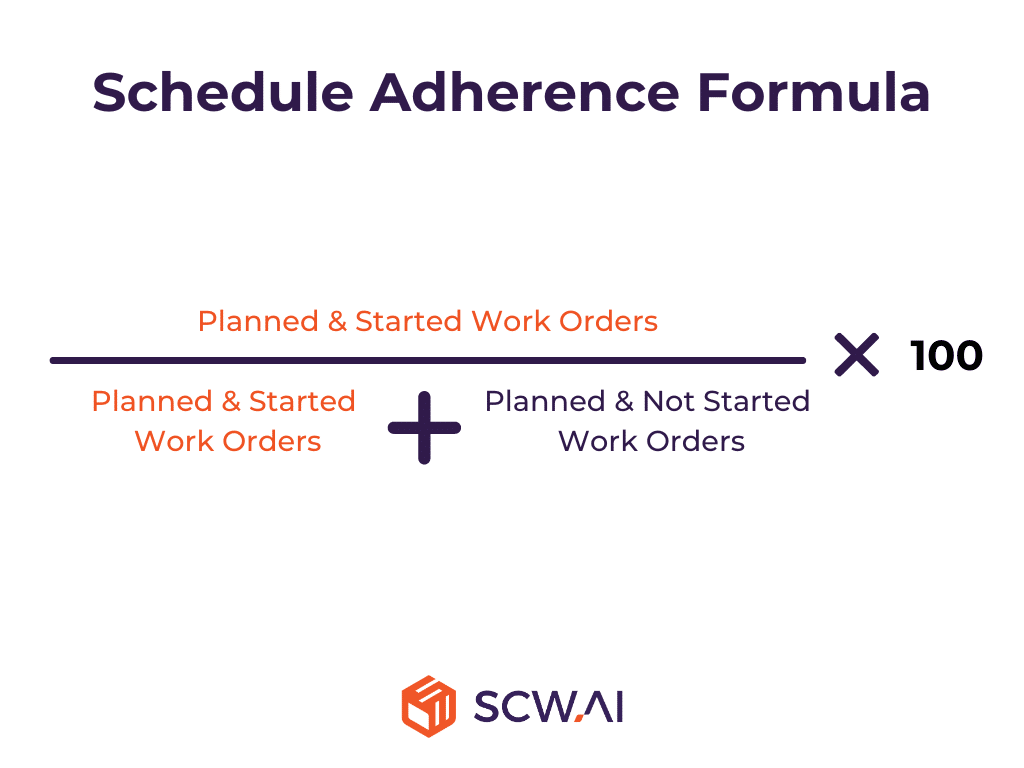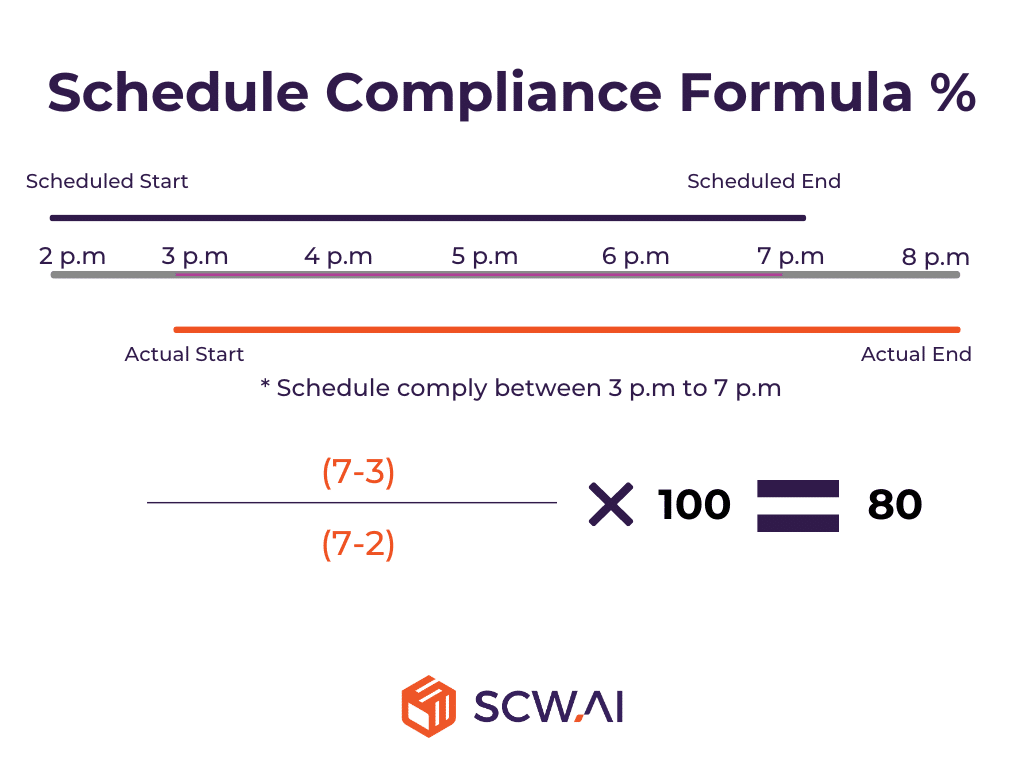In a 2016 report by Boston Consulting Group (BCG), it was asserted that manufacturing operations, especially significant ones, should not be tied to specific milestone dates, as adhering to such dates is often impossible. While it is unclear whether BCG still holds this perspective, recent advancements in production tracking technologies, advanced planning and scheduling (APS) systems, and digital twins have made significant strides in enhancing schedule adherence. This progress enables manufacturers to achieve greater reliability in their scheduling processes.
This article offers comprehensive insights into the scheduling adherence Key Performance Indicator (KPI), including its calculation, associated KPIs, and the ways in which manufacturers can enhance it through advanced technologies. Towards the conclusion of the article, we will introduce SCW.AI’s specialized tools and reports designed specifically to boost the schedule adherence of manufacturers.
What is Schedule Adherence for Manufacturers?
The schedule adherence metric evaluates how accurately a manufacturing schedule is executed by determining the percentage of work orders that were started as planned within a specific time period. This metric’s values start from 0% and can reach 100%, reflecting the extent to which scheduled activities align with actual production starts.
A benchmark for good schedule adherence typically falls between 90% and 100%. Schedule adherence below 90% suggests production delays, low OTIF score, low Overall Equipment Effectiveness (OEE), or unrealistic work orders that the shop floor cannot fulfill within the designated time frame.
How to Measure Schedule Adherence in Manufacturing
The schedule adherence formula in the manufacturing context is dividing the total number of started work orders scheduled for a given time interval by the number of total planned work orders (including not started ones) for that time window, then multiplying the result by 100 (see image below).

Schedule Adherence Example
A real-life example can illustrate the calculation of schedule adherence better. Suppose you scheduled 100 work orders for the weekdays between February 5 and February 9, 2024. If 85 of these scheduled work orders are started within this time interval and 15 remain unstarted, then the schedule adherence would be calculated as follows:
Schedule Adherence = (85 / (85 + 15)) × 100 = 85%.
Complementary Metrics to Schedule Adherence for Manufacturers
To evaluate the reliability of scheduling activities, relying solely on schedule adherence may lead to potential misinterpretations of factory efficiency, resource utilization, or scheduling effectiveness. Complementary metrics such as schedule compliance and schedule attainment provide a more comprehensive perspective on scheduling and production capabilities. Here is a comparison with schedule adherence:
Schedule Adherence vs Schedule Compliance
Schedule compliance is a percentage-based indicator that measures how closely the actual production time matches the scheduled production time (see the image below). For example, the schedule compliance would be 80% if a work order was supposed to begin at 2 p.m. to conclude at 7 p.m., but it really starts at 3 p.m. and ends at 8 p.m.

In contrast to schedule adherence, schedule compliance can offer more insights regarding the potential On-Time In-Full (OTIF) score of a work order. By assessing KPI executives can decide over work to complete work orders on time.
Schedule Adherence vs Schedule Attainment
Schedule attainment reflects the degree to which the actual production output aligns with the planned production output. The schedule attainment formula, as illustrated in the image below, accounts for unplanned and started work orders. Consequently, a consistently higher schedule attainment metric compared to schedule adherence may indicate that the factory is productive, but the scheduling team struggles to generate effective schedules.
Continuing from the previous example, where the number of planned and started work orders was 85, the not started ones were 15, and considering that the number of unplanned and started work orders is 10, the schedule attainment would then be 95%.

How can Manufacturers Improve Schedule Adherence
Manufacturers can improve schedule adherence by:
- Increasing factory visibility to identify production bottlenecks and taking prompt actions.
- Production scheduling optimization with AI models.
- Improving master data using digital tools to create more realistic schedules.
Following technologies address one or more points above:

1. Automated Reports and Dashboards
Automated reports and dashboards that showcase granular factory data are essential tools for manufacturing executives to uncover opportunities and bottlenecks hidden on the shop floor. SCW.AI identifies the following five automated reports and/or dashboards as valuable for enhancing schedule adherence.
1.1 Schedule Adherence Report
A Schedule Adherence Report presents data work order by work order, providing managers with insights into schedule adherence and complementary metrics such as schedule attainment and compliance. Manufacturers are advised to utilize such a report, which also showcases variances between planned and actual set-up, run, and clean-up times. This assists in identifying key inefficiencies that contribute to suboptimal schedule adherence (see image below).

1.2. OTIF Report
Prioritizing work orders with a low OTIF score can enhance the schedule adherence metric (see OTIF Formula Below). To achieve this, manufacturers require a report that displays real-time OTIF scores work order by work order. This approach not only helps in optimizing schedule adherence but also minimizes potential OTIF penalties and improves customer satisfaction by ensuring timely and complete delivery of work orders.

1.3. Takt Time Dashboard
Takt time represents the average speed of production required to complete work orders on time. For example, a manufacturer must produce a piece every 30 seconds to meet the deadlines of a work order. If the production falls behind the takt time, it can lead to delays and, over time, negatively impact schedule adherence and compliance metrics. Thus, monitoring real-time takt time metrics for each work order is essential, enabling agile actions such as dispatching a maintenance team for a machine with low performance or making informed decisions about the taking overtime.

1.4. Station Level Dashboard
Station or machine-level bottlenecks play a pivotal role in determining the overall speed of a production line, as the line’s pace is limited by its slowest machine (see the image below). Over time, stations and machines with suboptimal performance can detrimentally impact production and associated scheduling metrics. Consequently, it is recommended to implement a dashboard that allows line leaders to monitor the status and speed of each machine in real-time, facilitating prompt actions to maintain optimal production speed.

1.5. OEE Dashboard
As demonstrated in the image below, an OEE (Overall Equipment Efficiency) dashboard offers detailed insights into various types of losses. This enables manufacturers to identify whether setup processes, equipment failures, or speed losses are contributing to sluggish production. By pinpointing chronic issues on the shop floor, managers can implement strategic actions over time.

If you are curious about the average OEE of pharmaceutical manufacturers across partly digitized, digitized, and heavily digitized factories, you can explore our article on World Class OEE in Pharma: A Benchmarking Analysis.
2. AI-driven schedulers
According to BCG, AI-driven schedulers (APS systems), can add an extra 30 minutes of productive time for manufacturers each day. This additional time has the potential to significantly enhance schedule adherence and schedule compliance metrics, reducing the variance between schedule adherence and schedule attainment.
As illustrated in the image below, AI algorithms are highly adaptable to business needs. Whether a manufacturer prioritizes faster production, minimizes makespan, maximizing OTIF to avoid penalties, or ensuring on-time delivery, AI can be tailored to meet specific objectives.

To find out unique applications of AI for the manufacturing industry you can read our Top 5 AI Use Cases in Manufacturing article.
3. Predictive Maintenance
According to Deloitte, machine learning-driven predictive maintenance can enhance equipment availability by up to 20% and substantially increase the productive time of a factory. This means that manufacturers can develop more reliable schedules by minimizing the likelihood of machine failures.

4. Digital Twins
Digital twins have the capability to generate realistic simulations for factory operations using historical data. Consequently, factory twins prove beneficial for optimizing master data. For example, the scheduling team may plan a certain changeover duration as 2 hours, but upon analyzing historical data, the digital twin can forecast that this changeover duration actually takes 3 hours. This insight can prompt the scheduling staff to adjust the master data accordingly, enabling the creation of more realistic schedules and achieving a more optimal schedule adherence score.
How Can SCW.AI Improve Manufacturer’s Schedule Adherence?
SCW.AI’s Digital Factory Platform equip manufacturers with following capabilities to enhance their schedule adherence:
- Schedule Adherence Report: Tailored for manufacturers aiming to enhance schedule adherence, this report furnishes real-time insights into 10+ metrics, encompassing schedule adherence, schedule attainment, and schedule compliance. The Schedule Adherence report facilitates a granular comparison between planned and actual changeover and run-time durations, empowering manufacturers to pinpoint bottlenecks contributing to low schedule adherence.
- AI-driven Scheduler: Algorithms play a crucial role in optimizing scheduling with various objectives, and one such objective is makespan minimization. This ensures that work orders are efficiently orchestrated, resulting in a shorter production duration.
- OTIF Report: The Digital Factory Platform offers a real-time OTIF report at a granular level. This feature aids executives in efficiently prioritizing work orders and making informed decisions when it comes to production.
- Daily Production Performance Report: SCW.AI interprets takt time in this report. Daily Production Performance report provides line-level information on whether the current production speed aligns with the daily production target.
- OEE Tracker: Provides global, site, line, and even station-level information regarding OEE, machine and line status, and production speed.
To find out more regarding SCW.AI’s cloud manufacturing solutions you can book a demo now!


